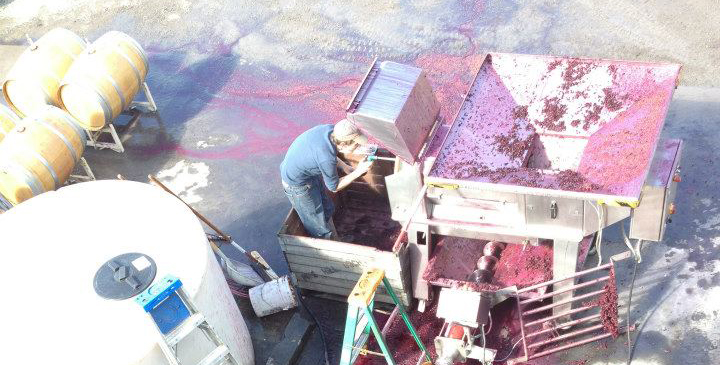
Red Newt Cellars on the east side of Seneca Lake in the Finger Lakes was founded in 1998 by David and Debra Whiting. David Whiting focused on the winemaking and Debra developed one of the first farm-to-table restaurants in the Finger Lakes within the winery. Tragically Debra Whiting died in 2011. Harvard educated Kelby James Russell took over winemaking duties in 2011.
The winery has achieved critical success including having been named among Wine & Spirits Magazine’s 2011 Top 100 wineries of the year. The winemaker Kelby James Russell was featured in Riesling expert Stuart Pigott's ebook Rock Stars of Wine America: FLXtra with KJR.
Red Newt makes single vineyard designated Riesling, Gewürztraminer and Pinot Gris as well as limited quantities of Pinot Noir, Cabernet Franc and Merlot.
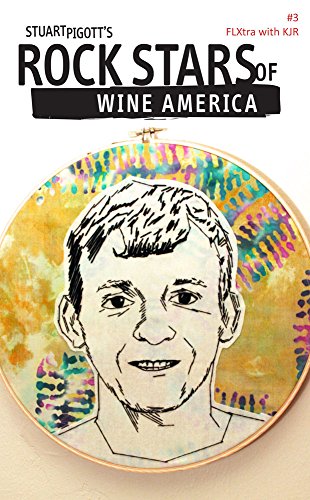 Christopher Barnes: Kelby, how did you become a winemaker?
Christopher Barnes: Kelby, how did you become a winemaker?
Kelby James Russell: My winemaking career started similarly to a lot of people in the Finger Lakes in that it was apprenticeship-based. Wasn't a part of my family tradition. My parents enjoyed a glass of wine with dinner, but there is no real wine connection within my family, certainly not in the state or anything like that. In the Finger Lakes, it's still a bit of a frontier in the Wild West for winemaking degrees. It's great if you have a degree, but it's not required or necessary by any means. The experience, especially given how crazy the weather can be here, and having to deal with the vintage variation here, is very important. Having boots-on-the-ground experience is, in some ways more important than having a degree.
I graduated from college in 2009, which was a great time to not be looking for a job, and decided to rather than pursuing my career path of orchestra management, give winemaking a try with an apprenticeship during the harvest here in the Finger Lakes, and see if I liked it. See if I was any good at it. Then, I figured if both those things worked out, then great. I could keep trying. If they weren't good, I would go back to the job search that I was going to have started anyway.
That was 2009. Fortunately I was good at it, it seems. I started at Fox Run on the northwest side of Seneca Lake. Then showed up in a dress shirt and khakis, because I thought that I was interviewing with Peter Bell, the winemaker there. I showed up on the first day of harvest because I did not realize what I was doing. I thought it was an interview. He hadn't clarified. They handed me a shovel to start shoveling all the junk coming out from the crusher, destemmer, and the grape skins, totally oblivious to what I was wearing or what the expectations might have been. I was there basically every day from that point forward for, I don't know 40 or 50 days until the harvest was over, obviously dressing much more appropriately afterwards.
I really enjoyed it. Loved it. Decided to go to New Zealand that following winter to get another harvest in in the Southern Hemisphere. Came back. Went to Fox Run again. Then went to Australia the following two Winters, once in Tasmania at Pipers Brook, and then once in Barossa at Yalumba. That was the end of my crash course of winemaking. It was three years and six harvests. Then, I landed here at Red Newt.
Talk a little bit about Red Newt. What's the background of this estate?
Red Newt was founded in 1998 by a husband-and-wife team, Dave and Debra Whiting. Dave was the winemaker. He'd been a winemaker around the Finger Lakes since the late '80s. He had cut his teeth at McGregor. Then Standing Stone up the road, CLR down the road. Decided it finally got to the point where he could establish his own place. Debra, his wife, was a great chef, and had been doing catering, and was looking for an actual place to open a restaurant. It was envisioned right from the start as both a winery and a bistro really celebrating local food, which in 1998 was well ahead of the curve. Lead the whole local food movement, which is fantastic. That's within the last, certainly the last 10 years if not the last five. It's really taken off. 1998 was trailblazing, especially in this region.
1998 was the first vintage. The bistro and the wines went on sale in 1999. Dave was a front-runner on really serious dry Riesling right from the start, and Riesling in general. It was his passion. It was becoming many people's passion in the region, but he was really pushing the envelope right from the start here. Deb was really pushing the envelope on the food side. This was the first white tablecloth sort of establishment on the lakes sort of that time. It was a great dining spot. Always booked up during the summer. The two of them were really quite a dynamic duo up until she tragically passed away in 2011.
That's the point that Dave decided to step back a little bit. He's still the owner, and still very actively involved. He stepped back from the day-to-day of winemaking and cellar work. That's about the time I was brought in initially as an assistant winemaker. Then about six months after that as full winemaker.
 You have a winery but you source your grapes from four specific growers that you're very involved with. Tell us a little bit about that relationship.
You have a winery but you source your grapes from four specific growers that you're very involved with. Tell us a little bit about that relationship.
Red Newt does not own vineyards per se. We actually do own about an acre of Concord right in front of the winery that someone else takes care of. Instead of owning grapes or growing grapes, what we do have is long term relationships with four particular growers. One is our Pinot Gris and Gewürztraminer grower. His name is John Santos. He's just up the road from us at Curry Creek Vineyard. One vineyard for all our reds called the Glacier Ridge Vineyard, which is also just to the north of us, right on the lake, run by Tony and Lou Damiani. Then, our Riesling, especially since about 2008, has come predominantly from two vineyards. One is Tango Oaks Vineyard which is just down the slope from us. Fred Wickham is the grower. That's a beautiful five-acre block that Red Newt paid for the planting of in exchange for a long-term contract and access to the fruit. it's a beautiful five-acre Riesling block on gravel and an Alsatian clone.
Then still across the lake from us, technically three miles away, but as the crow flies, but a lot longer by car, is Lahoma Vineyard. Lahoma Vineyard is managed by Harlem Fulkerson, brother of Sarah Fulkerson at Fulkerson Winery. Harlem is a grower, a great site, 15 acres of Riesling there that were planted in the same way as Tango Oaks. Red Newt financed the purchase of the vines basically in no interest loan in exchange for access to the fruit, and really helped both of those vineyards establishes themselves when they wouldn't have been able to otherwise.
From the Red Newt perspective, it's great because we both have the fruit, but we also have a great relationship with the growers. I'm on the phone with Fred and Harlen quite a bit even in the off season, checking in seeing how things are going. Then, once we get into the growing season, I'm obviously over at the vineyards fairly frequently, and then always in touch once we get into the harvest time, and are really trying to drill down what we want to do and when we think it's going to happen. The sort constant tension between the grower who wants to pick and the winemaker who wants to wait. We have little squabbles there.
It's a really good arrangement as it allows them to focus on what they're good at which is growing the grapes beautifully. It allows us to focus on what Dave was great at. Now, we're working in the cellar which is making the wines the best that we can.
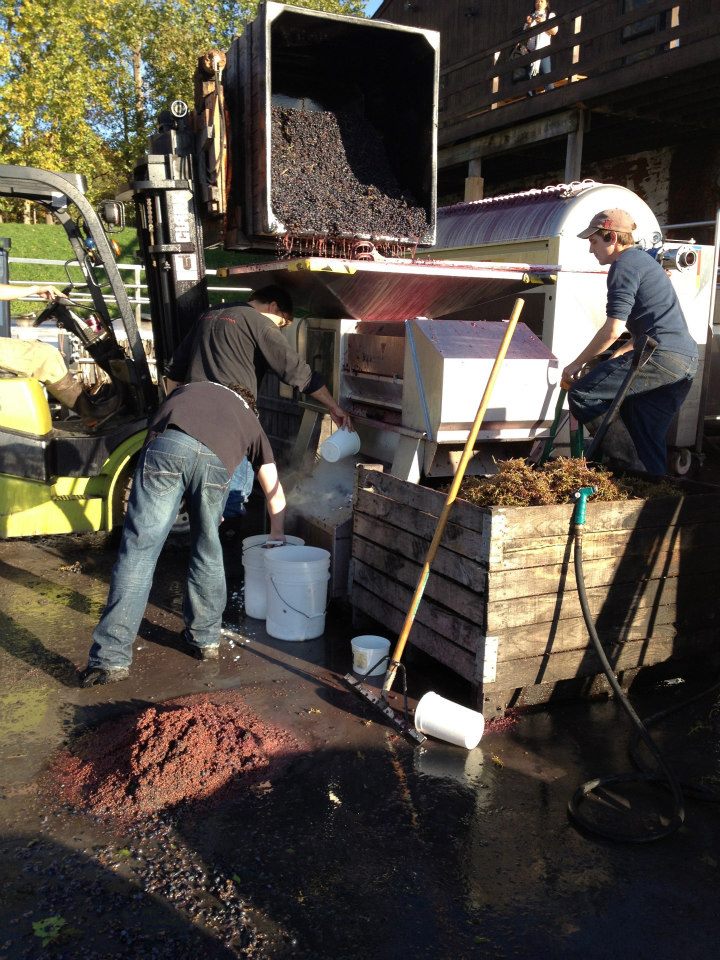
(Photo: David Whiting, Kelby Russell and Brandon Seager)
Tell us a little bit about the terroir of the Finger Lakes.
The terroir of the Finger Lakes is remarkably varied in a micro sense. The large-scale sense, we really owe our existence do the Great Lakes. As much as everyone talks about the Finger Lakes and the microclimate they provide, the microclimate would be pointless if we didn't have the moderating effects of particularly Lake Ontario, which is just a huge heat sink that keeps everything up here able to grow in the spring and into the fall.
Then the Finger Lakes, Seneca Lake is right behind us here, they are what really allowed the microclimate to flourish, that takes a decent climate and turns it into a great climate for vinifera especially your German vinifera, for the most part or Alsatian varietals. That's the overarching weather view for terroir.
When it comes to soil, the sky's really the limit. There's not a ton of limestone in the Finger Lakes. That's the one thing we don't really have. There's some limestone up in Cayuga Lake. That's not as common. What we do have is a bedrock of shale everywhere which is great, perfect for Riesling in particular. Then your top soil on top of that is glacial till. The lakes were carved up by the glaciers. All of the landscape here is carved by the glaciers. Really, what they decided to melt and drop on their way out is what your top soil is even to this day, which means even within the same vineyard block as we're walking down a row, we can walk from one soil type into another soil type entirely. The vines are responding totally differently. I think maybe planting in the Finger Lakes 20 years ago wasn't quite aware of those differences. Now, it's really something people are really digging into and paying attention to.
Within our Riesling, we have the Tango Oaks Riesling Vineyard, which is on 20 feet of gravel before bedrock because of a flood that deposited the gravel there in 1934. Then the Lahoma Vineyard is generally sandy and gravelly, very Austrian in some ways in that context, and really free draining. Then, there's a two-acre block within Lahoma that's an entirely different soil type than all of the Rieslings surrounding it, that we call "the knoll." It's our top site, a really beautifully draining site. There, you have a vineyard right in the middle of the vineyard, there's just a two-acre patch of totally different soil than everything else around it. The terroir of the Finger Lakes in the large scale, it's great for these beautiful refreshing, really lean white wines. When we're digging into vineyard by vineyard, and what the potentials are, the exciting thing is how varied it is.
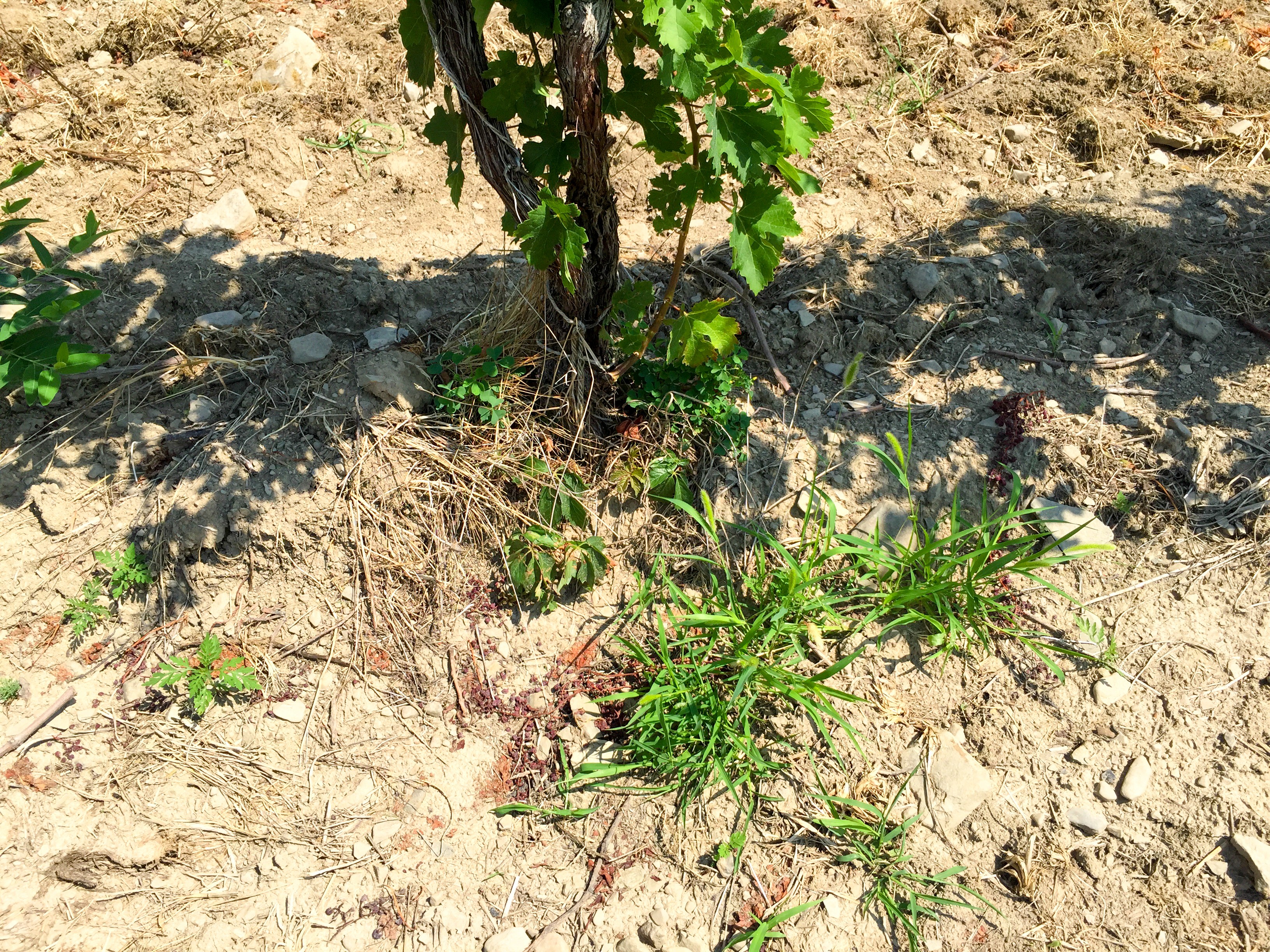
(The soils at Glacier Ridge Vineyard)
In terms of vintage variation how much do the wines change from year to year?
We do our best to keep the wines from year to year, when we're looking at the vintages, we try to keep the vintage variation true. We want to express the fact that every vintage is its own. We have some wines that we're trying to maintain a house style that people can recognize regardless of the vintage, or perhaps they can recognize the house style as viewed through the lens of the vintage. Then when we get to our single-vineyard wines, the fun in those is that we really let the vintage show through. The point of the single-vineyard wines is not to be the same every year. It's really to showcase the fact that the Finger Lakes, despite being in the wine New World, has more in common with the wine Old World in terms of not just the fact that the wines are a little bit cooler, but also that one year to the next we don't know what the temperature is going to be. We don't know what the precipitation is going to be.
You can still have a ringed up harvest here, or you can have a harvest that doesn't start until the second or third week of October because we're waiting for the right amount of heat accumulation, which as a winemaker and as a grower can be challenging and really frustrating in the moment. I think as a consumer, when you find out what the vintages are and figure out what you should look for, and then as a winemaker when I'm tasting wines from around the Finger Lakes, it's really rewarding to have that level of differentiation from year to year. The wines really speak to the year they came from. It's really clear.
How are they different? What are some examples of how wines come out differently based on weather patterns?
I think even just these past few years, you can see the differences in the wines themselves. I think my first vintage was 2009, which was a distinctly cool, long vintage. Picking wasn't really happening until October. Those wines, thinking of Riesling in particular, we're really lean and electric right from the start which might not be everyone's preference. Certainly, it was possible to leave the Riesling a little sweeter to account for that, but the standard dry Riesling was incredibly tight, really nervy and energetic and aging beautifully because of that higher acid content.
Followed by 2010 which was the warmest vintage on record, and incredibly sunny. There was actually even some drought stress issues which is not normally what we are talking about in the Finger Lakes. Those wines are, as you would expect, pretty voluptuous, really, really juicy, some of them almost have, to be honest some of them have a thickness to them that isn't always pleasant. It was such an oddball vintage that no one had had to deal with before and that's some of what resulted.
When we had a repeat of 2010 and 2012, if you taste the 2012 you're tasting the vintage variation, but also winemaker ordering, which I think is a cool story. The fact that it was a very similar vintage to '10, but the wines are much more refreshing, much more focused. They still have the ripe fruit that you would expect from a warmer year. They also have the acid balance that you want from a Riesling or from a Pinot Gris or what have you. That's really an example of how the vintages just don't affect the grapes, they affect the winemakers too. As we learn how to deal with that, we make wines that are corresponding better, I hope.
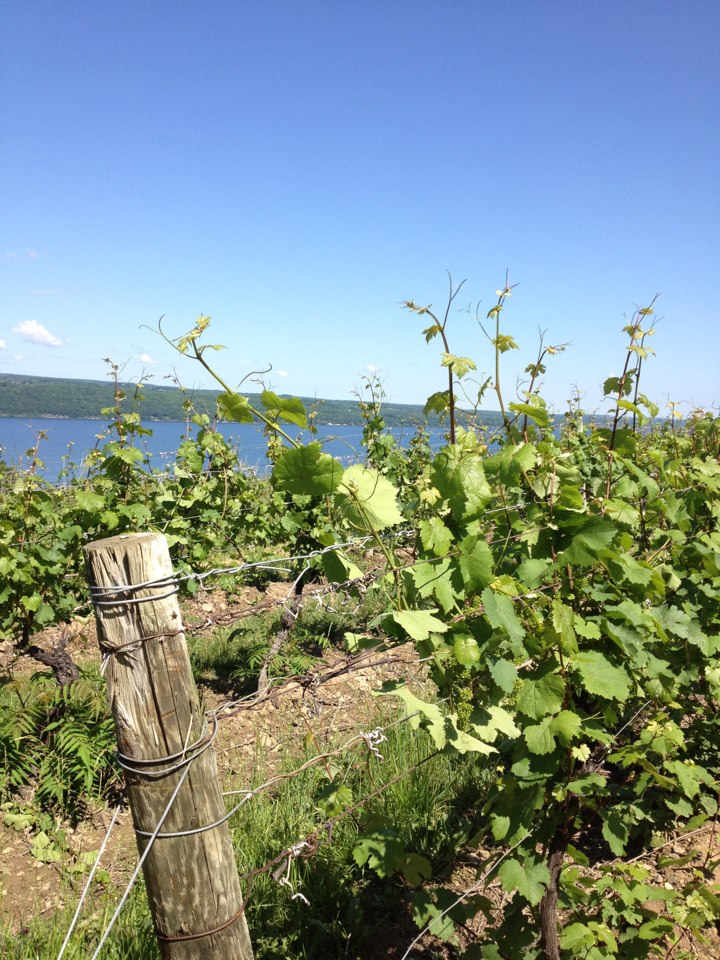 How has winemaking changed in the Finger Lakes over the years? I think there's certainly a lot more international people here, and there's a lot more focus on the Finger Lakes internationally.
How has winemaking changed in the Finger Lakes over the years? I think there's certainly a lot more international people here, and there's a lot more focus on the Finger Lakes internationally.
I think winemaking has changed in the Finger Lakes in that it is the Wild West. The rules haven't been written here. If you're a young winemaker from anywhere in the world, and if you're interested in Riesling or cool-climate wines, the exciting thing about coming to the Finger Lakes is that the sky's the limit for making your mark on what the wine styles can be, and what the wines look like and what can be done here, because there's so much yet to be done. I think that's the exciting thing that people are coming for. If there is a result of that, I think the larger story of Finger Lakes winemaking is diversity of styles, which is a fantastic thing. If you were to come in the '80s or '90s, there would have been some bad wines because the region wasn't totally professionalized at that point. The good wines, largely probably would have fit into one or two stylistic camps.
The grapes would have been different from different vineyards, and they'd be different wines because of that. Largely, the sort of techniques in the cellar and the philosophical idea of what a good Finger Lakes wine was was broadly agreed upon. I think the exciting thing now is that the number of acceptable styles of Finger Lakes wine is really opening up. You see totally different expressions, totally different styles in the vineyard, styles in the winery. Styles in the bottle for the same labeled style of dry Riesling, for example. It can just be all over the place which is, again, what attracts people to the region because you can really make that mark. Also, I think it's a healthy thing for the region to have that level of diversity.
Talk about the reds a little bit. I mean I remember coming here maybe eight or nine years ago and visiting a few wineries. The reds all had this bell peppery underripe kind of taste to them. Now, you're making some really terrific reds in the Finger Lakes. How has that evolved?
Reds in the Finger Lakes, that's mostly, I would say a story of success in the vineyard in terms of when we're looking at the ripeness of the red grapes in the vineyard and knowing how to handle them later into the season. All credit to the vineyard management and those working on it whether it's Cornell, or whether it's professional advisories that have really helped get red grapes to the correct level of ripeness that they went to be at. It's not to suggest that it's a struggle to get them ripe here, I think it's just something that hadn't been broadly pursued. It's really beautiful when you get ripe red wines from a cool-climate region, because you get both the ripeness but you also get the refreshing structure whether tannin or acid that makes them great food pairing wines.
I think that's the story of red winemaking in the Finger Lakes right now, largely a story of vineyard work which I suppose means the ball is in the winemaker's court. We'll take it.
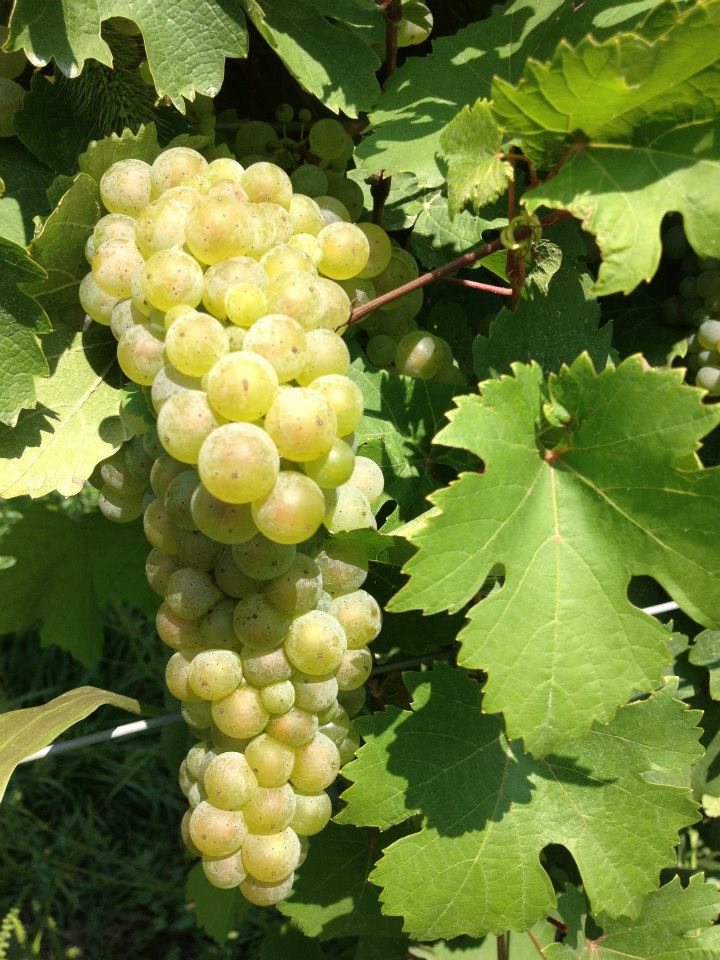 Other than Riesling, what grapes are you most excited about?
Other than Riesling, what grapes are you most excited about?
Other that or Riesling, I would say the most exciting great we work with is probably Cabernet Franc. We're having so much fun exploring the different expressions of Cab Franc here. We have a vineyard that we get really big tannic Cab Franc from every year. That's a vineyard site characteristic that's really fun. We have a vineyard that gets a really beautiful fruit-forward, more relaxed Cab Franc from every year. We have a vineyard that I work with personally that tends to deliver a much leaner, more herbal style of Cab Franc. Not the green bell pepper, but definitely that herbal side that exists in the grape, which is both beautiful for rosé, but also makes a stunning ... what we would call a Loire-style Cab Franc, as well. It's ripe. It still has those green notes to it.
There are so many other exciting grapes. I mean, I think Syrah is exciting. I think Lemberger is exciting. I would love to see Sylvaner planted, which there is none. I think it would be a fun grape to work with. Cab Franc, at least in terms of what we have access to, is both exciting and something that we can really take a crack at every year.
How do you describe your personal philosophy of winemaking?
Our philosophy of winemaking here, or mine in particular, in general, our saying last year was, "Let it ride," because we'd have fermentations that would start to smell reductive, is the term. They would smell like cabbage, perhaps. There'd be beautiful fruit underneath. The choice was whether to try and correct what was mucking up the aroma on top, or just let it work itself out naturally rather than having to give into additions. Because we've been doing so much work in the vineyard, with our growers, and because we're so careful in the winery, we had the confidence to just say, "You know what, this is going to work out on its own. We're going to get a better wine as a result of letting it work out on its own."
I think that's largely been proven. I mean, we're really happy with what's coming out of the cellar. There's some great texture to our Rieslings now, as a result of that, that I think is somewhat unique to the region. Perhaps, becoming a bit of a house style for us, whether for better or worse. It all comes back to really just working incredibly hard in the winery and in the vineyard so that when things come up, we can actually sit back and relax.
Buy Stuart Pigott's eBook starring Kelby James Russell on Amazon for $4.99.
Buy Red Newt on Grape Collective or check Winesearcher for a retailer near you.














